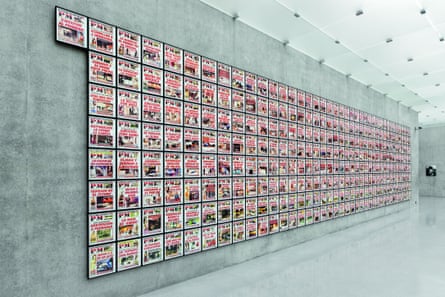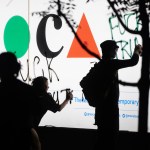It’s a bright, sunny day in Barcelona and I’m in a dark gallery watching a woman pull a scroll out of her vagina. Outside, skateboarders circle the CCCB, one of the city’s foremost arts centres. Inside? A naked teenage girl is eating her master’s excrement in a clip from Pier Paolo Pasolini’s 1975 film, Salò, or the 120 Days of Sodom.
Sade: Freedom or Evil is an exhibition exploring the influence and reputation of the notorious French writer and philosopher the Marquis de Sade – from whose name the term sadism derives. It is not for the faint-hearted. It opens with a reproduction of his only extant authentic portrait, a 1760 sketch of the 19-year-old De Sade by Charles Amédée Philippe van Loo, and juxtaposes it with Joan Fontcuberta’s collage composed of 6,060 Google image search results for “Sade” and associated terms. The purpose of Fontcuberta’s piece is to depict current impressions of the Ancien Régime-Revolution straddling provocateur; amusingly, there are plenty of shots of the Smooth Operator singer mingled among entwined limbs from hardcore movies.
It is the sort of intelligent and curious work that typifies Freedom or Evil. For much of history, including during his lifetime, De Sade has been cast as mere pornographer, a cartoon sensationalist or a twisted sicko. It’s this characterisation that co-curators Alyce Mahon and Antonio Monegal are intent on challenging.
A Parisian nobleman born in 1740, De Sade spent almost three decades of his life in prison, mostly to deter and suppress his explicit and macabre writings. One prison sentence was the result of him sending his novel, Juliette – which runs the full Sadeian gamut from murder to incest to cannibalism – to Napoleon, which was rather asking for it.
There is no act of depravity that De Sade found too stomach-churning. His most famous work – but in its unfinished state, his least accomplished – 120 Days of Sodom features a woman being raped to death atop a bed of nails. And that’s not even the most shocking vignette. Written on a 12-metre scroll, it was smuggled out of the Bastille into the febrile, pre-terror atmosphere of Revolution. Two years ago it was acquired by the French state for €4.55m.

De Sade’s writings were not about sex for the sake of sex. Or rather, they were, but as part of the overarching philosophy that the consummation and realisation of desire, erotic or otherwise, represents the apotheosis of human liberty. Sade was both libertine and libertarian. He critiqued and satirised institutions, often wittily advertising the hypocrisies of church, state, class, law and family. As questions of freedom and free expression are, naturally, perennial, Sade: Freedom or Evil becomes not just a historical show but a contemporary one.
The first section of the exhibition focuses on the distribution and original presentation of Sade’s work. Sex sells, and his clandestine works were no exception. On display are first editions and engravings from a 1797 pirated second edition of Justine, the (literal) sister novel to Juliette. There is a fantastic Leonor Fini illustration from a 1944 edition of Juliette: a gouache whirlwind of female dominance in the muscular form of two women raising whips in a fine-brushed kinesis.
Surrealists such as Fini revered De Sade and revived his output; they were his natural heirs in their unfettering of the unconscious and carnal, hedonistic approach to the aesthetic. There are three Dalí works here, including a full-breasted portrait of everyone’s erotic fave, Gradiva; and also Man Ray’s cheeky 1933 homage to De Sade: a pair of male buttocks framed by an upside down cross.
The exhibition also examines De Sade’s relevance to queerness and kink in the latter half of the 20th century. In particular, the flourishing fetish culture of the 1970s that saw the likes of gay BDSM club Mineshaft become a staple of the New York underground club scene. There are three photographs included here from Susan Meiselas’ 1995 series Pandora’s Box, her revisiting of the dominatrix studio she first documented 20 years earlier.




Robert Mapplethorpe’s infamous X Portfolio (1978), featuring a liberal amount of fisting, is also present. When it was exhibited in 1989, it led to public outrage, a debate around US art funding and – 35 years after the publisher Jean-Jacques Pauvert was taken to court for reissuing De Sade’s texts – an obscenity trial. Mapplethorpe was heavily influenced by Pierre Molinier, a correspondent of André Breton’s, and included are two of Molinier’s black-and-white self-portraits, in which he wears a corset, stockings and suspenders and high-heels. With a fully made-up face, he smiles into the camera. It’s heartening to see such overtly queer and sexually unapologetic work at a time when LGBTQ+ rights are under threat across the globe.
De Sade has long been accused of misogyny but he was also praised by the likes of Simone de Beauvoir. Just as his writing encompassed queer practices and passions, so too did they often feature the sexual autonomy of women and the rejection of hetero-patriarchal norms. Juliette, for instance, is a counter to the archetype of the submissive woman, whether in reality or myth.
In Angela Carter’s The Sadeian Woman, she argued that De Sade was a “moral pornographer”. Carter’s position was not to praise Juliette as some kind of horny girlboss – she took part in the same gruesome acts as the men – but that, in making her just as awful, De Sade was affording her equal status. It seems something of an anomaly that there is no excerpt of Carter’s treatise here, although there are intriguing simulated dialogues in which critics and philosophers enter into conjectured conversations with Michel Foucault, among others (these are available to watch online). There are also extracts from Pauline Réage’s Histoire d’O (1954), an erotic novel that would have made Sade proud.
after newsletter promotion




The most visceral installation on the subject of violence against women is the Domestic Data Streamers’ commissioned soundscape, The Rhythm of Violence. In a darkened room, time is warped: every minute equates to a year, and every tick of a series of metronomes – which represent different countries – is the death of a woman at the hands of her partner or ex-partner. It might have come off as gimmicky – recall that Make Poverty History advert with Brad Pitt clicking his fingers? But it isn’t. Meanwhile, Laia Abril’s photographs of defiled uniforms and costumes from her On Rape series expose the abuses of women ingrained in the institutions that Sade so abhorred.Was De Sade evil? That is a question the exhibition aims to explore – sometimes in a startlingly bracing manner. There is a manga comic, Shin Gendai Ryoukiden, and an explanation of its main source: the horrific, four-month brutal torture of a 17-year-old student in Japan, the real-life details of which make it hard not to sympathise with the philosopher Michel Onfray’s assertion that it is “intellectually bizarre to make Sade a hero”. It’s noticeable that Freedom or Evil does not afford any space for Onfray’s point of view, nor others of its disposition.Likewise, it would have been fascinating to see a psychiatrist’s take on De Sade, and maybe a deeper look at the relationship between prison and psychiatric institutions in general – De Sade was confined to one towards the end of his life.
We are appalled by evil and yet we are perpetually drawn to it. Freedom or Evil offers plenty of evidence of our bloodlust, a perverted feedback loop of perpetrators and voyeurs. One of the most arresting pieces is Mexican artist Teresa Margolles’s staggering PM (2012), an entire wall of 313 front pages from a tabloid published in the drugs and gang-ravaged border town of Ciudad Juárez. It’s a swathe of violence, just as bloody as the set piece of any horror film. It is evidence of the casual barbarity that pervades society and the mainstream appetite for its detail that De Sade was condemned for.
Violence outside sexual and domestic settings is addressed in an excoriation of the depraved acts and repercussions of colonialism. A Kara Walker film, The Creation of the African-America (2005), argues the indivisibility of American identity from the enduring, brutal legacy of slavery. And the Argentine artist and activist Marcelo Brodsky overlays graphic archive photographs of the victims of genocide with bright, bridging watercolour and unmitigated phrases (“We abused you”) in the – unrepentant? – language of colonisers.




There is room, too, for the infamous photograph of American soldier Lynndie England humiliating prisoners at Abu Ghraib, which remains as shocking a decade later.
Freedom or Evil is not the only recent show to have analysed De Sade’s enduring celebrity. In the past couple of decades, there have been several exhibitions, including at the Musée d’Orsay, and a number of books, the latest of which is Joel Warner’s The Curse of the Marquis de Sade. De Sade has even become a character in the Assassin’s Creed video game, although I won’t hold my breath on his adorning keyrings à la Frida Kahlo.It hardly needs saying that this is a show that will not appeal to everyone. Not least those less inclined to indulge work in which children are skinned alive and pregnant women disemboweled. Which is why, back on the streets of Barcelona, I keep a sharp eye out for prospective candidates to whom to gift my complimentary exhibition tickets. It feels like carrying a bomb only certain people would be brave enough to defuse. I alight on two young men on a bench, who may or may not be lightly flirting with one another. I ask them if they like art and if they like sex. They do. So I explain the show and ask them if they would be able to handle it? They look at each other and laugh. “Yes,” they reply. “We do porn.”
This post was originally published on this site be sure to check out more of their content.






